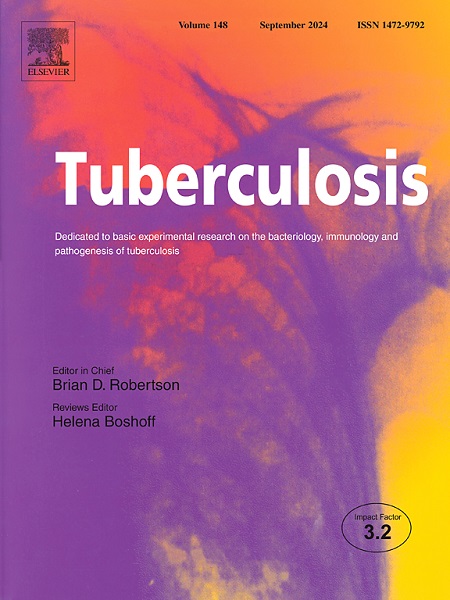接种疫苗一年后,牛分枝杆菌致病因子 PhoP、ESAT-6 和 CFP-10 突变体在小鼠器官中持续存在
IF 2.9
3区 医学
Q3 IMMUNOLOGY
引用次数: 0
摘要
我们迫切需要一种牛结核病疫苗。卡介苗(Bacille Calmette-Guérin)是目前唯一获准用于人类的结核病疫苗,但对牛的保护作用却不尽相同。然而,卡介苗是一种高度安全的疫苗,任何替代疫苗不仅要提供比卡介苗更强的保护力,还必须符合并提高其安全性。小鼠是结核病研究中使用最广泛的动物模型,尤其是用于临床前疫苗评估。在这些动物模型中,感染或疫苗疗效的关键指标是肺部的分枝杆菌负荷。在本研究中,我们评估了用缺乏毒力基因 phoP、esxA 和 esxB 的牛分枝杆菌三重突变体为 BALB/c 小鼠接种疫苗所产生的长期保护作用。我们的研究结果表明,三重突变体能在接种后一年内保护小鼠肺部免受牛分枝杆菌的侵袭。然而,脾脏中的细菌负荷主要由疫苗菌株构成,肺部也含有其中一些细菌。这些结果表明,疫苗菌株在小鼠器官中至少存在一年,这引起了人们对其在动物疫苗接种中潜在安全性的担忧。本文章由计算机程序翻译,如有差异,请以英文原文为准。
Mycobacterium bovis mutant in the virulence factors PhoP, ESAT-6 and CFP-10 persisted in mouse organs after a year post-vaccination
A vaccine for bovine tuberculosis is urgently needed. The BCG vaccine (the Bacille Calmette-Guérin), currently the only licensed vaccine for tuberculosis in humans, offers variable protection in cattle. However, BCG is a highly safe vaccine, and any alternative vaccine must not only offer greater protection than BCG but also match and improve its safety profile. Mice are the most widely used animal models in tuberculosis research, particularly for pre-clinical vaccine evaluation. In these animal models, the key indicator of infection or vaccine efficacy is the mycobacteria load in the lungs. In this study, we evaluated the long-term protection conferred by vaccinating BALB/c mice with a Mycobacterium bovis triple mutant lacking the virulence genes phoP, esxA, and esxB. Our findings showed that the triple mutant protected the lungs of mice against M. bovis challenge for up to one-year post-vaccination. However, the bacterial load in the spleens predominantly comprised the vaccine strain, and the lungs also contained some of these bacteria. These results suggest that the vaccine strain persisted in the mouse organs for at least one year, which raised concerns about its potential safety for animal vaccination.
求助全文
通过发布文献求助,成功后即可免费获取论文全文。
去求助
来源期刊

Tuberculosis
医学-呼吸系统
CiteScore
4.60
自引率
3.10%
发文量
87
审稿时长
49 days
期刊介绍:
Tuberculosis is a speciality journal focusing on basic experimental research on tuberculosis, notably on bacteriological, immunological and pathogenesis aspects of the disease. The journal publishes original research and reviews on the host response and immunology of tuberculosis and the molecular biology, genetics and physiology of the organism, however discourages submissions with a meta-analytical focus (for example, articles based on searches of published articles in public electronic databases, especially where there is lack of evidence of the personal involvement of authors in the generation of such material). We do not publish Clinical Case-Studies.
Areas on which submissions are welcomed include:
-Clinical TrialsDiagnostics-
Antimicrobial resistance-
Immunology-
Leprosy-
Microbiology, including microbial physiology-
Molecular epidemiology-
Non-tuberculous Mycobacteria-
Pathogenesis-
Pathology-
Vaccine development.
This Journal does not accept case-reports.
The resurgence of interest in tuberculosis has accelerated the pace of relevant research and Tuberculosis has grown with it, as the only journal dedicated to experimental biomedical research in tuberculosis.
 求助内容:
求助内容: 应助结果提醒方式:
应助结果提醒方式:


